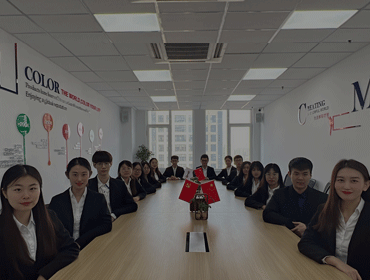Dyes are colored organic compounds that can dye fibers or other substrates into a certain color. Generally speaking, they are those coloring
substances used in textile dyeing. They can generally be divided into natural dyes and synthetic dyes.Dyestuffs are rich in types and have
a huge industrial chain, including upstream chemicals, midstream intermediates and dyes, and downstream printing and dyeing. The
process involves many fields such as chemicals, intermediates, manufacturing, and printing and dyeing.
The upstream industries of the dye manufacturing industry are the petrochemical industry, basic chemical industry and coal chemical industry.
The main raw materials are chemical products such as benzene, naphthalene, anthracene, heterocyclics, and inorganic acids and alkalis.
The midstream covers dye intermediates and dye preparation.The preparation of dyes goes through the process of aromatics-intermediates-dyes.Intermediates play an important role in the dye industry chain.They build a bridge between basic chemicals and fine chemicals.
At present, there are more than 500 kinds of common dye intermediates. Among them, the intermediates required for the manufacture
of disperse dyes mainly include m- phenylenediamine, reductants, hexabromo, and hexachloro, etc. Theintermediates required for the manufacture
of reactive dyes mainly include para-ester, H acid, J acid, etc.
The downstream is dominated by textile printing and dyeing. Printing and dyeing companies are mainly responsible for dyeing finished
materials such as grey fabrics, and charging dyeing fees from downstream textile and clothing companies. At present, textiles and clothing
are the largest terminal demand for dyes, accounting for more than 90% of the total dye demand, and its market prosperity is directly affected.
To the dye demand.
After 2010, due to the increasing downward pressure on the global economy and environmental supervision and other factors, the output of
printing and dyeing fabrics of enterprises above designated size in China continued to decline. Entering 2016, as the domestic economy
stabilized and rebounded, the printing and dyeing industry focused on promoting transformation and upgrading. The output of printing
and dyeing fabrics began to turn positive from negative growth for five consecutive years, reaching 53.370 billion meters, an increase of 4.74% year-on-year. Due to environmental protection and other reasons, China's printing and dyeing output above designated size was 49.069 billion meters in 2018, a year-on-year decrease of 6.46%. The prosperity of the textile industry rebounded in 2019, and the output of printed and dyed fabrics in the first
four months was 14.655 billion meters.Natural dyes are derived from plants, animals and minerals, and synthetic dyes are reprocessed
through coal chemical or petrochemical processes. Among them, synthetic dyes can be divided into direct dyes, acid dyes, cationic dyes,
reactive dyes, disperse dyes, sulfur dyes and condensation dyes according to their properties and application methods.




